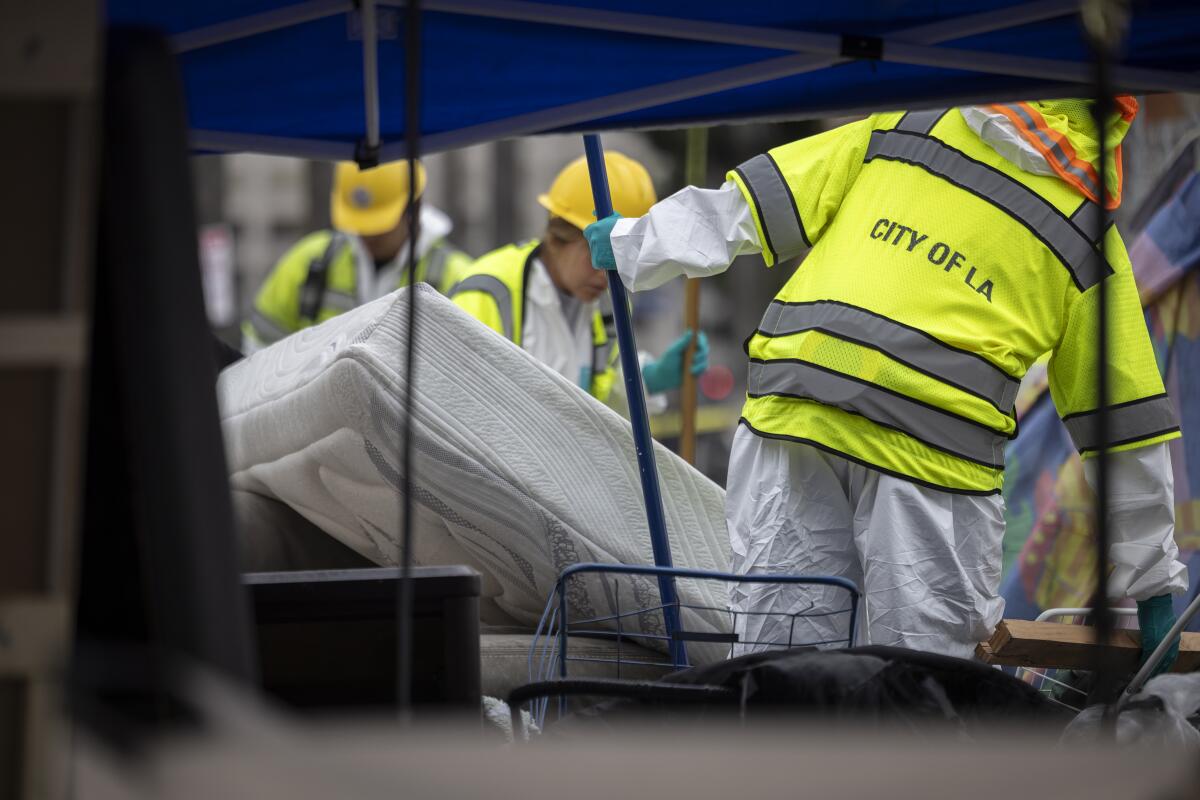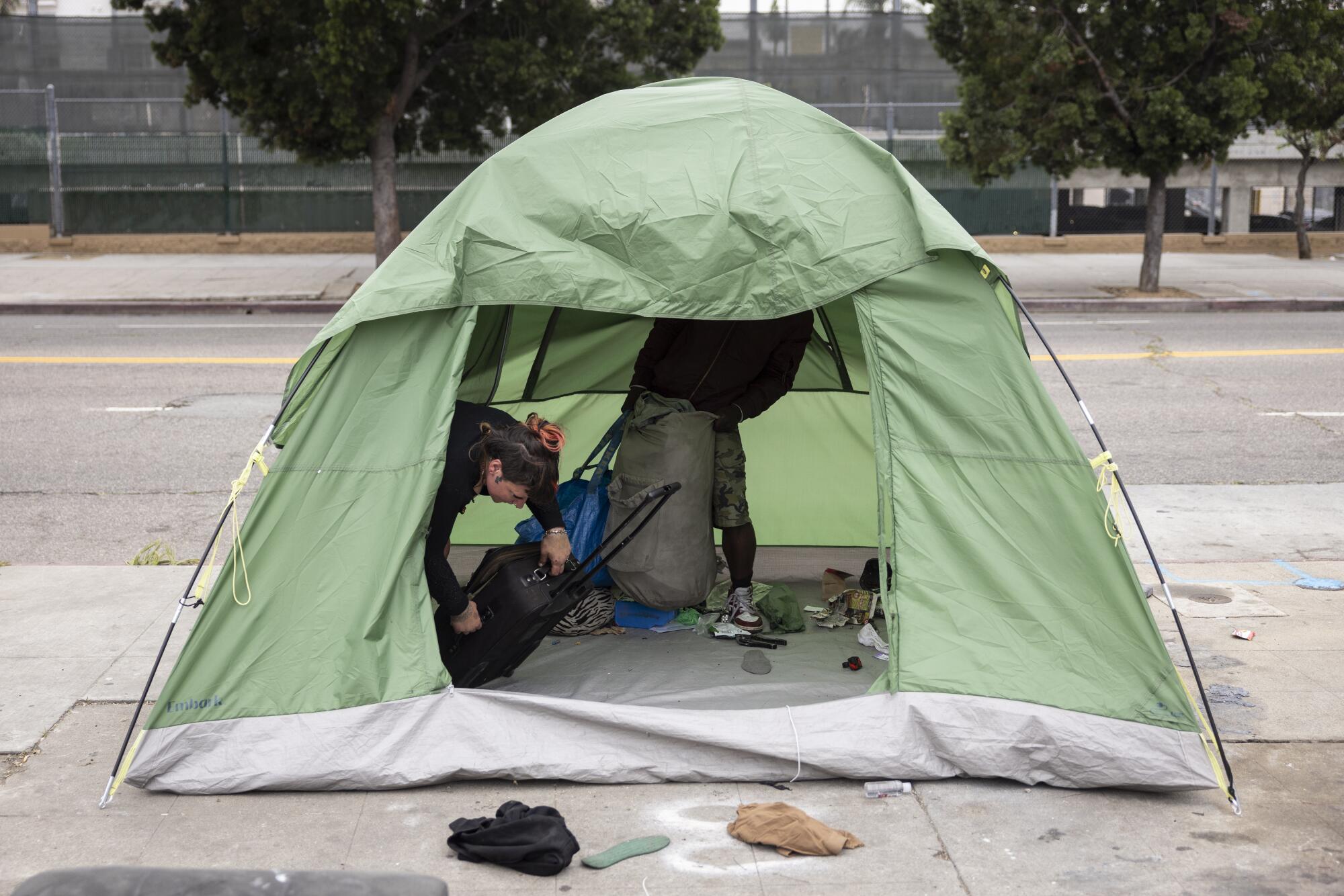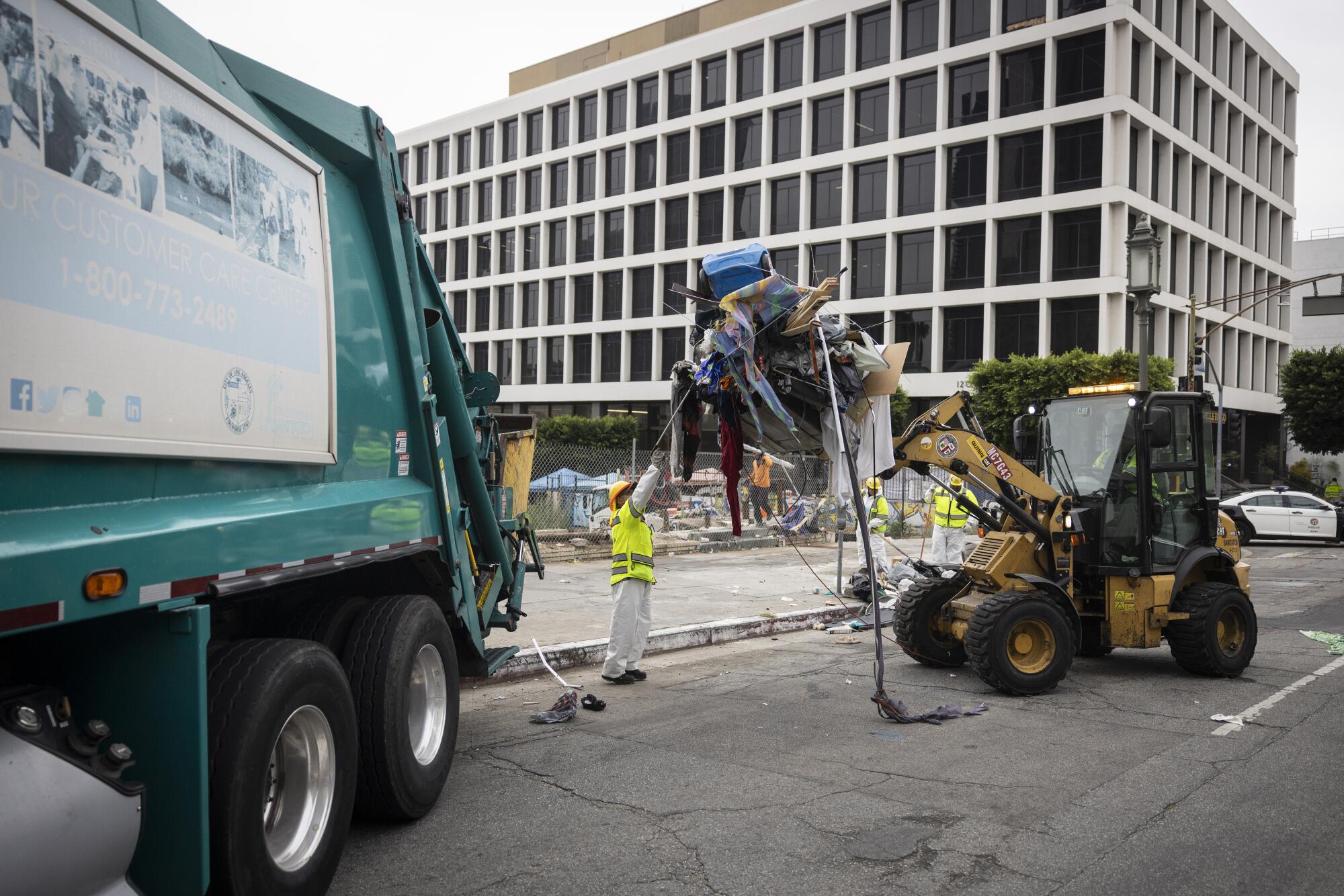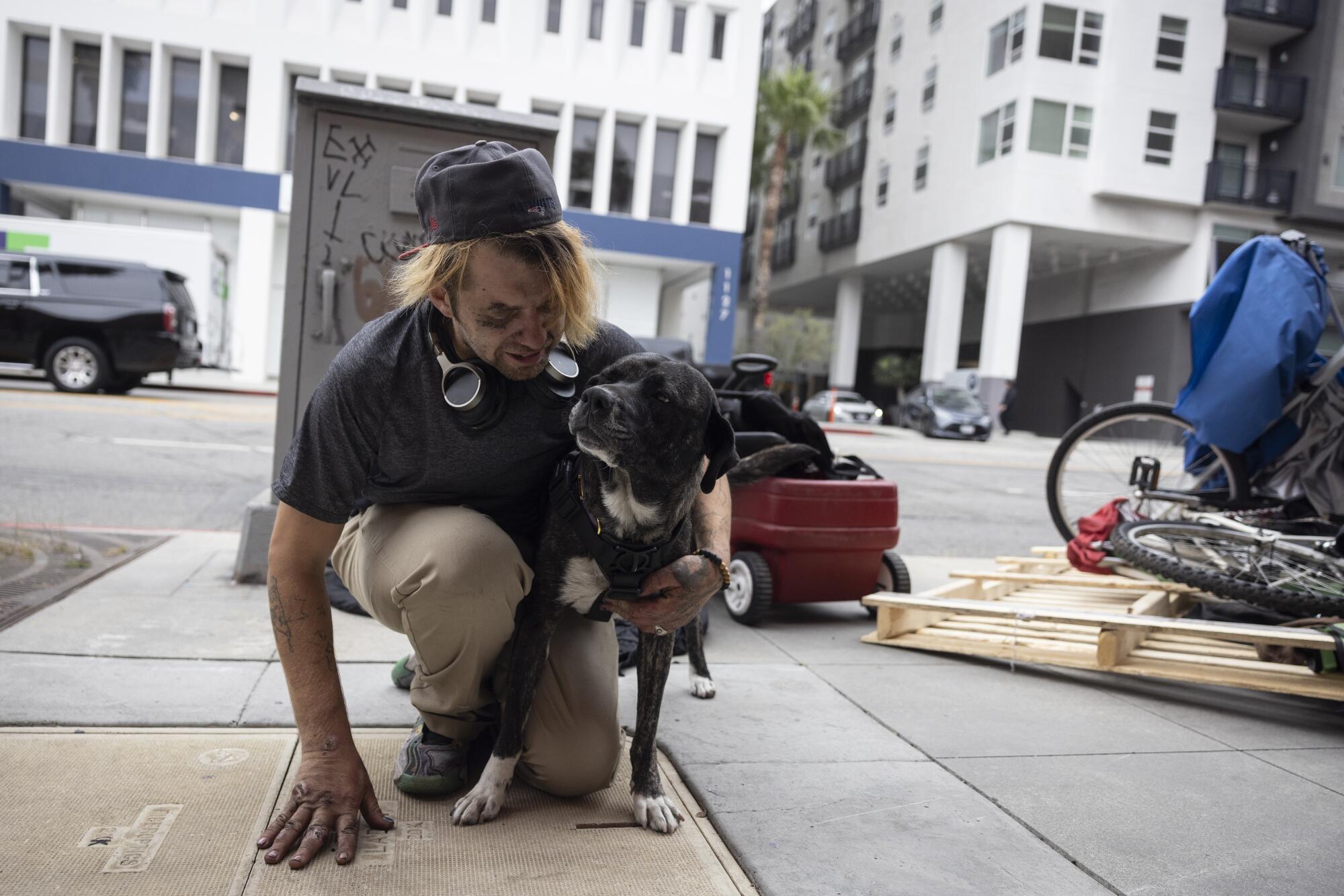-
Thune Says Russia Sanctions Vote Could Come as Soon as This Month - 11 mins ago
-
Red Sox Star Jarren Duran Offers 4-Word Response on Lost Playing Time - 24 mins ago
-
A Surgeon Shares What She Saw in Gaza’s Hospitals - 55 mins ago
-
Supreme Court Deals Blow to Republican Immigration Law in Florida - 59 mins ago
-
Jeffrey Epstein’s Brother Reacts to Trump Administration’s Review of Case - 2 hours ago
-
Body found inside a Goodwill donation bin in Pasadena - 2 hours ago
-
X CEO Linda Yaccarino Says She Is Leaving Elon Musk’s Platform - 2 hours ago
-
$1 Billion Washington, DC, Rail Bridge Project Moves Forward - 2 hours ago
-
Fireworks warehouse explosion: Authorities search home of CEO - 2 hours ago
-
Israel Launches New Ground Incursion in Lebanon, Raising Fears for Truce - 2 hours ago
L.A. must remove 9,800 encampments. But are homeless people getting housed?
Musician Dennis Henriquez woke up in a doorway in East Hollywood last month, hidden behind cardboard and sheltered by a tarp.
When he peered outside, half a dozen sanitation workers were standing nearby, waiting to carry out one of the more than 30 homeless encampment cleanups planned that day by the city of Los Angeles.
Henriquez eventually emerged, carried out a bicycle and deposited it on a grassy area 20 feet away. He also dragged over a backpack, a scooter, two guitars, a piece of luggage and a beach chair.
The city sanitation crew grabbed the tarp and the cardboard, tossing them into a trash truck. Then, the contingent of city workers, including two police officers, climbed into their vehicles and drove away, leaving behind Henriquez and his pile of belongings.
This type of operation, known as a CARE-plus cleanup, plays out hundreds of times each week in the city, with sanitation crews seizing and destroying tents, tarps, pallets, shopping carts and many other objects.
The cleanups have emerged as a huge source of conflict in a five-year-old legal dispute over the city’s handling of the homelessness crisis. Depending on how the cleanup issue is resolved, the city could face legal sanctions, millions of dollars in penalties or increased outside oversight of its homeless programs.

A construction loader plows through the remains of a homeless encampment on Wilshire Boulevard, just west of downtown.
(Etienne Laurent / For The Times)

Sanitation crews grab a mattress during the cleanup. (Etienne Laurent / For The Times)

A notice about the cleanup is displayed on a utility pole on Wilshire Boulevard. (Etienne Laurent / For The Times)
In 2022, city leaders reached a legal settlement with the nonprofit L.A. Alliance for Human Rights, promising to create 12,915 homeless beds or other housing opportunities by June 2027. Eventually, they also agreed to remove 9,800 homeless encampments by June 2026 — with an encampment defined as an individual tent, makeshift structure, car or recreational vehicle.
To reach the latter goal, city leaders have been counting each encampment removed from streets, sidewalks and alleys during the Bureau of Sanitation’s CARE-plus cleanups — even in cases where the resident did not obtain housing or a shelter bed.
The alliance has strongly objected to the city’s methodology, arguing that destroying a tent, without housing its occupants, runs afoul of the 2022 settlement agreement. Any “encampment resolution” tallied by the city must be more permanent — and address the larger goal of reducing homelessness, said Elizabeth Mitchell, an attorney for the alliance.
“If the person insists on staying where they are and nothing else has happened, that’s not a resolution,” she said. “They can’t count that.”
City leaders have carried out CARE-plus cleanups for years, saying they are needed to protect public safety and restore sidewalk access for wheelchair users, the elderly and others. Some encampments are strewn with debris that spills across an entire walkway or out into the street, while others carry the smell of urine, fecal matter or decaying food waste.
The cleanups have a Sisyphean quality. Many seasoned residents drag their tents across the street, wait out the cleanup, then return to their original spots in the afternoon. The process frequently restarts a week or two later.
The alliance’s legal team, alarmed by the inclusion of CARE-plus cleanups in the encampment reduction count, recently spent several days trying to persuade a federal judge to seize control of the city’s homelessness initiatives from Mayor Karen Bass and the City Council and turn them over to a third-party receiver.
U.S. Dist. Judge David O. Carter, who presides over the case, declined to take that step, saying it went too far. But he has made clear that he, too, objects to the city’s approach to eliminating the 9,800 encampments.
In March, Carter issued a court order saying the city may not count CARE-plus cleanups toward its goal because, as the alliance had argued, they are “not permanent in nature.”
Last month, in a 62-page ruling, he found the city had “willfully disobeyed” that order — and had improperly reported its encampment reductions. Clarifying his position somewhat, the judge also said that the city cannot count an encampment reduction unless it is “accompanied by an offer of shelter or housing.”
“Individuals need not accept the offer, but an offer of available shelter or housing must be made,” he wrote.
Attorney Shayla Myers, who represents homeless advocacy groups that have intervened in the case, has opposed the 9,800 goal from the beginning, saying it creates a quota system that increases the likelihood that city workers will violate the property rights of unhoused residents.
“Throwing away tents doesn’t help the homelessness crisis,” she said. “Building housing does.”

Shayna, a person experiencing homelessness, moves things out of a tent during the June 24 encampment cleanup.
(Etienne Laurent / For The Times)
City Administrative Officer Matt Szabo, who helped negotiate the settlement, told the court last month that his office does not count the tents that homeless people move temporarily — around the corner or across the street — during city cleanups. However, the city does include those that are permanently removed because they block the sidewalk or pose a public health or safety threat, he said.
Szabo, during his testimony, said that when he negotiated the promise to remove 9,800 encampments, he did not expect that every tent removal would lead to someone moving inside.
The city is already working to fulfill the alliance agreement’s requirement of creating 12,915 homeless beds or other housing opportunities. On top of that, Szabo said, encampment residents have “free will” to refuse an offer of housing.
“I wouldn’t ever agree that the city would be obligated to somehow force people to accept [housing] if they did not want to accept it,” he said. “We never would have agreed to that. We didn’t agree to that.”
For an outside observer, it might be difficult to discern what the different types of city encampment operations are designed to accomplish.

Mary, a person experiencing homelessness, speaks with a police officer during the June 24 cleanup.
(Etienne Laurent / For The Times)
Bass’ Inside Safe initiative moves homeless people into hotel and motel rooms, and at least in some cases, permanent housing. By contrast, CARE cleanups — shorthand for Cleanup and Rapid Engagement — are largely focused on trash removal, with crews hauling away debris from curbs and surrounding areas.
CARE-plus cleanups are more comprehensive. Every tent must be moved so workers can haul away debris and, in some instances, powerwash sidewalks.
Sanitation crews are supposed to give residents advance warning of a scheduled CARE-plus cleanup, posting notices on utility poles. If residents don’t relocate their tents and other belongings, they run the risk of having them taken away.
In some cases, cleanup crews take the possessions to a downtown storage facility. In many others, they are tossed.

A construction loader transports the remnants of the Westlake encampment to a city garbage truck.
(Etienne Laurent / For The Times)
One of the largest CARE-plus cleanups in recent weeks took place in the Westlake district, where nearly three dozen tents and structures lined a stretch of Wilshire Boulevard. A construction loader drove back and forth on the sidewalk, scooping up tents and depositing them in a trash truck.
Ryan Cranford, 42, said he didn’t know the cleanup was scheduled until minutes beforehand. He wound up losing his tent, a bed and a canopy, but managed to keep his backpack, saying it contained “all that matters.”
Sitting on a nearby retaining wall, Cranford said he would have accepted a motel room had someone offered one.
“Hell, I’d even take a bus to get all the way back to Oklahoma if I could,” he said.
On the opposite side of the street, Tyson Lewis Angeles wheeled his belongings down the street in a shopping cart before sanitation workers descended on his spot. He said an outreach worker had given him a referral for a shelter bed the day before.

Tyson Lewis Angeles, a person experiencing homelessness, holds his dog, Nami, before city sanitation workers descended on his spot on Wilshire Boulevard.
(Etienne Laurent / For The Times)
Angeles, 30, said he was not interested, in part because he deals with panic attacks, PTSD and other mental health issues. He also does not want a roommate, or the rules imposed by homeless shelters.
“Basically, it’s like volunteer jail,” he said.
While Angeles managed to safeguard his possessions, others are frequently less successful.
Nicholas Johnson, who is living in a box truck in Silver Lake, said city crews took the vast majority of his belongings during a CARE-plus cleanup in mid-June. Some were destroyed, while others were transported by sanitation workers to a downtown storage facility, he said.
Johnson, 56, said he does not know whether some of his most prized possessions, including letters written by his grandmother, went into that facility or were tossed. City crews also took books, tools, his Buddhist prayer bowls and a huge amount of clothes.
“All of my clothing — all of my clothing — the wearables and the sellables, all mixed in. Hats, scarves, socks, ties, a lot of accessories that I wear — you know, double breasted suits from the ’30s, the suit pants,” he said.

Nicholas Johnson, who lives with his dog, Popcorn, in a truck parked in Silver Lake, said the city took many of his prized possessions during a recent encampment cleanup.
(Jason Armond / Los Angeles Times)
Johnson said the city’s cleanup process is a “harassment ceremony” that only makes life more stressful for people on the street.
“They hit you in the kneecaps when they know you’re already down,” he said.
Earlier this year, city officials informed the court that they had removed about 6,100 tents, makeshift shelters and vehicles — nearly two-thirds of what the agreement with the alliance requires. Whether the city will challenge any portion of the judge’s ruling is still unclear.
In a statement, a lawyer for the city contends that the ruling “misconstrues the city’s obligations.”
“We are keeping open our options for next steps,” said the lawyer, Theane Evangelis.
Source link



















